The wind has been, for centuries, the driving force that has propelled humanity and led it to previously unknown territories. It has helped shape and mold landscapes of our planet, and currently plays the crucial role of generating energy for our own development. Without the wind and its control, the development of life, including technology, culture and history, would not have been possible.
It is an important factor, though not always predominant. In some cases, it is decisive. Along with other factors such as temperature, sun exposure, or rainfall, it contributes to define climates, mesoclimates, and microclimates found in any part of the world.
Spain is known for its climate diversity. Despite being a relatively small territory, the Iberian Peninsula harbors a myriad of climates, which over time have shaped cultures and ways of life. Northern Spain or Portugal has little in common with the more southern parts, for instance.

THE UNIQUE CLIMATE OF THE JEREZ ZONE
Climate and weather have motivated the migratory movement of civilizations, conquests, and changes in lifestyles. The Phoenicians already realized that the climate of Jerez zone was suitable for grape cultivation, giving rise to a tradition that has been rooted in the region for more than 3,000 years and still continues to this day. What led those ancient civilizations to choose this region?

The Marco de Jerez is the southernmost wine region in continental Europe. It is located northwest of the province of Cádiz in the extreme south of the Iberian Peninsula very close to Africa. To the west, the region is flanked by the Atlantic Ocean and is located within the area delineated to the east by the Greenwich meridian 5º 49 West and to the north by the parallel 36° 58’ North.
Sherry region climate is primarily influenced by two large seas with different temperatures and characteristics: the Atlantic and the Mediterranean. The region serves as the gateway for Atlantic storms and rough weather. The combination of its low latitude, proximity to the Atlantic Ocean, Africa, and the Mediterranean Sea results in a coastal climate for the Jerez region, characterized by mild temperatures and relatively high humidity (with some exceptions in certain areas). The Atlantic has a significant influence on temperature regulation in this area.
The climate of this PDO is characterized by a moderate temperature range, without prolonged periods of high temperatures or extreme coldwaves. The average annual temperature typically ranges from 15ºC to 19ºC (59ºF to 66ºF), while the rainfall varies between 600 and 700 mm.
These conditions make the region’s meteorology particularly unstable, facing challenges in weather forecasting. Jerez is an area where forecasting rain, wind shifts, or rainfall is hard to handle. Sherry region is unpredictable. It always gives room for surprises or extreme weather changes.
THE INFLUENCE OF LATITUDE: WARMTH AND SUNLIGHT
Latitudes suitable for viticulture are found between 32º and 51º in the northern hemisphere and between 28º and 42º in the southern hemisphere. The temperature decreases by 1ºC every 180 km towards the north and south poles, creating colder climates in the northernmost regions of Europe, for example, or very warm year-round areas near the Equator (0º parallel).
Jerez is located at parallel 36º in the northern hemisphere, very close to the limit of the ideal space for grape growing. The fact that this DO experiences a lot of sunlight, very hot summers, and mild winters is partly due to its geographical position, approximately 6,000 km north of the Equator.

THE BALANCING ACT OF THE ATLANTIC OCEAN: HUMIDITY AND MILDNESS
However, not only latitude is a determining factor in shaping the climate of Jerez. The ocean plays a fundamental role, as mentioned before, regulating temperature and establishing a characteristic level of humidity in the area. Despite being within the suitable latitude range for viticulture, without the presence of the ocean, it would be very difficult to achieve the high quality found in the wines of this PDO.
Simultaneously, there is another factor related to meters above sea level: altitude. Altitude influences atmospheric pressure and temperature; therefore, at higher altitudes, there is lower atmospheric pressure and lower temperature. Jerez is not a region with significant altitude, mainly due to its proximity to the Atlantic. However, altitude does contribute to the wonderful diversity of mesoclimates within the region. For example, Jerez is slightly warmer and less humid than El Puerto de Santa María.
The altitude and proximity to the sea directly influence the initial planning of vineyards and the daily operations of wineries. Lower altitude and closer proximity to the sea result in less temperature variation and a smaller contrast between maximum and minimum temperatures. Conversely, higher altitude and greater distance from the sea lead to more significant temperature differences. The vineyards of Lustau provide a perfect example:

• Montegilillo is the perfect example of the characteristic albariza vineyard of Jerez: a moderate elevation, located in the inland area of Jerez de la Frontera (at pago Montegil), with a notably interesting slope. Around 33 Km from the Ocean and an altitude of 65 – 87 m above sea level. Temperature (and mainly humidity) are different: this vineyard is warm, directly influenced by the sun, with little effect from the ocean, creating a low rate of humidity. Consequently, vines and grapes ripe early, promoting an early harvest.
• Las Cruces, however, is the perfect model of a less known style of vineyard in the region: a property that is very close to the Atlantic (3 Km), with almost no elevation (just 31 m above the sea level in its highest point) and located in Chipiona. Las Cruces is, as an opposite to Montegilillo, 100% coastal. Hence, grape ripe slower than inland and harvests are generally the last ones of the region.

DOMINANT WINDS: PONIENTE AND LEVANTE
A determining factor to understand the wind in Sherry region is the presence or absence of the Azores High (areas of high atmospheric pressure) in the area. In winter, the anticyclone (high-pressure) usually descends to the Canary Islands, allowing the passage of storms (areas of low atmospheric pressure) and initiating the rainy season in the region. In summer, it tends to move up, blocking the area and preventing the passage of the aforementioned storms. The air moves from high-pressure areas to low-pressure areas, thus generating wind currents.
This wind is one of the most prominent climatic features of the region due to its frequency and intensity, as well as its diversity.
LEVANTE: THE HOT, DRY WIND
This wind is known for its dryness, high speed, and strength. It is originated in the Alboran Sea (a small sea within the Mediterranean) and moves toward the Strait of Gibraltar. It is often strengthened as it passes between the Iberian Peninsula and the Rif-Atlas. These two continental masses create the Venturi effect, accelerating the speed of the Levante wind as it approaches the strait.
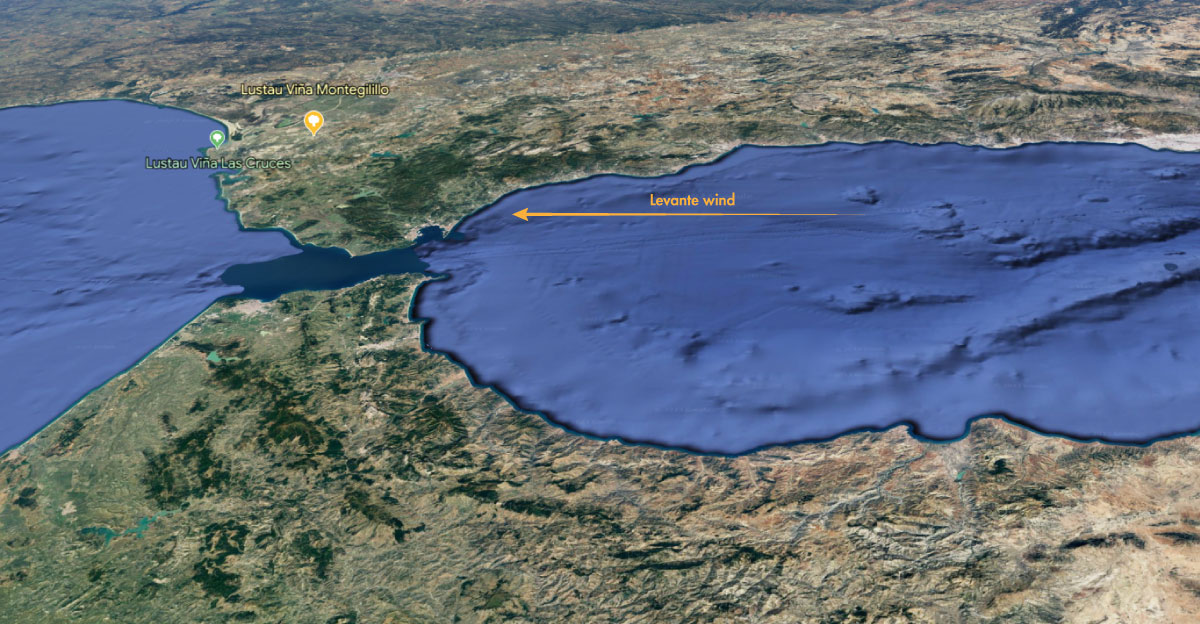
The levante wind is also very persistent. In summer, constant gusts of wind can last for 7 days or more, creating a dry atmosphere throughout the region. This is ideal to prevent excessive humidity influenced by the Atlantic and promote healthy grape ripening.
If this wind originates from the sea and passes through the strait, why is it dry? The levante wind carries humid air from the Mediterranean. However, it is slowed down by the mountains in the southern part of the peninsula, around Malaga (around 200 Km/ 136 m from Jerez), reducing the humidity and transforming it into a completely dry wind.
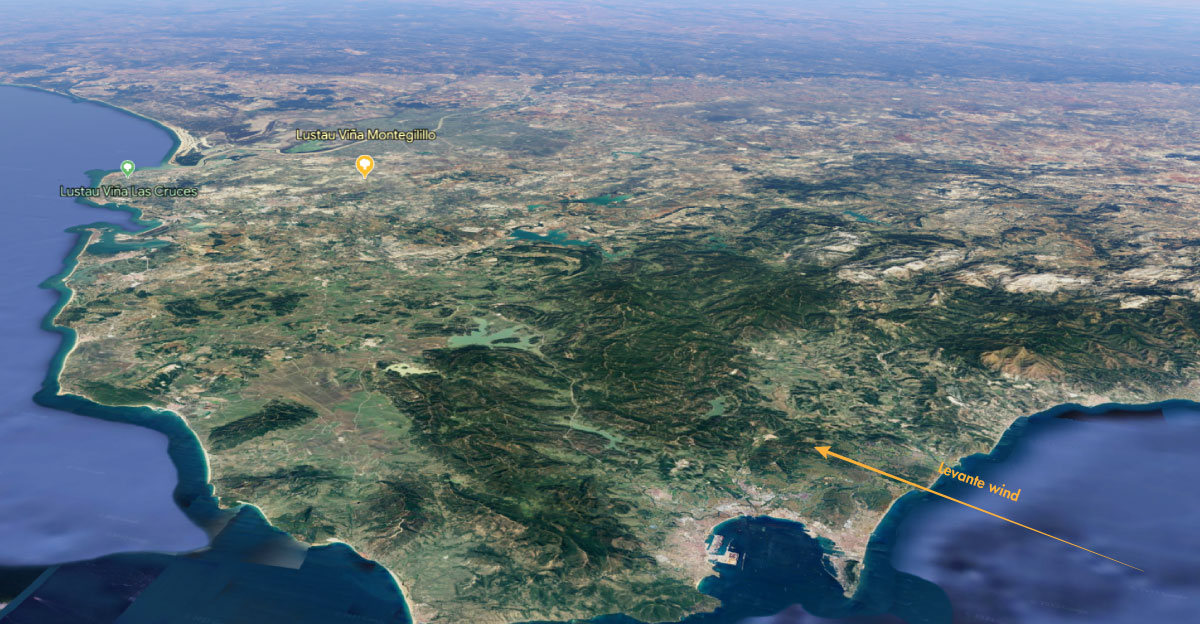
PONIENTE: THE COOL, HUMID BREEZE
The poniente wind is the opposite of the levante wind due to the presence of storms and cloud masses moving from the western part of the province of Cádiz to the Alboran Sea. It also originates in storms that cross between parallels 40 and 35 or in the northern part of Spain.
This wind is also strong and fast, though less so than the levante wind. It tends to be more prominent in the months of fall and winter (October to April). It is characterized by being humid and cold, making it ideal for maintaining the environmental conditions inside the winery as stable as possible.
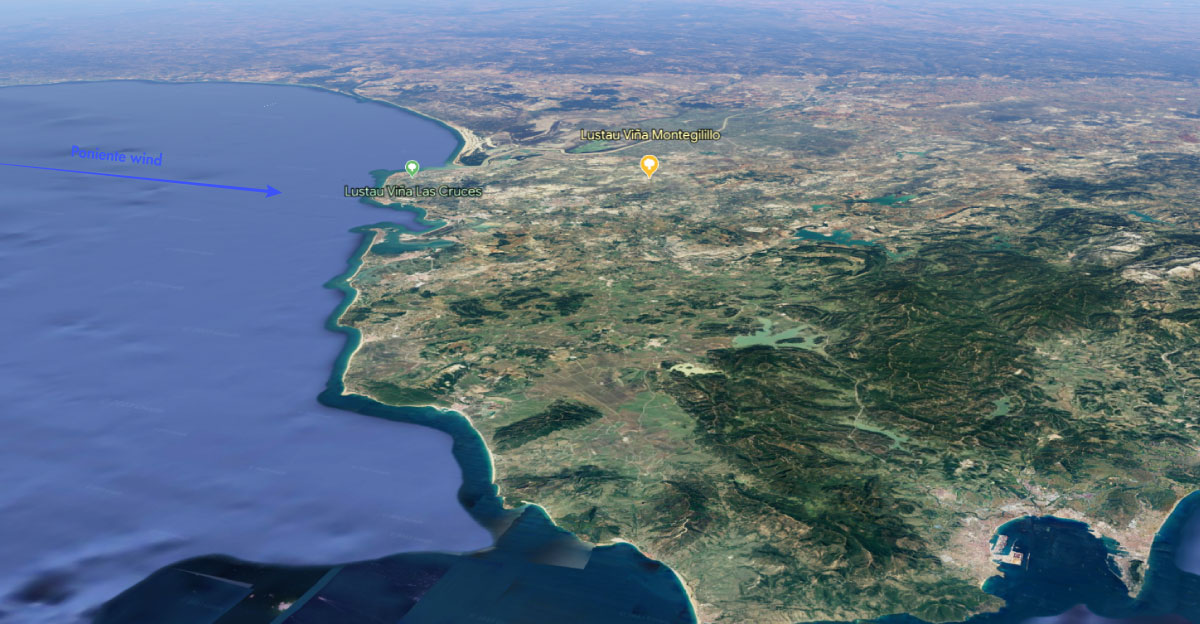
IT IS NOT JUST WARM AND DRY. ARE THERE OTHER WINDS IN THE REGION
Sherry wind rose is broad and diverse. The region is not only influenced by the levante and poniente winds. There are other winds with different orientation that play a significant role. The presence of each type of wind in each town or subzone of the Designation of Origin (DO) will also be key to understand part of the climatic identity of vineyards, wineries, and ultimately, wine styles.
◦ Jerez de la Frontera: The levante wind has a certain dominance with speeds ranging from 0.5 meter/ s to 5.7 meter/ s.
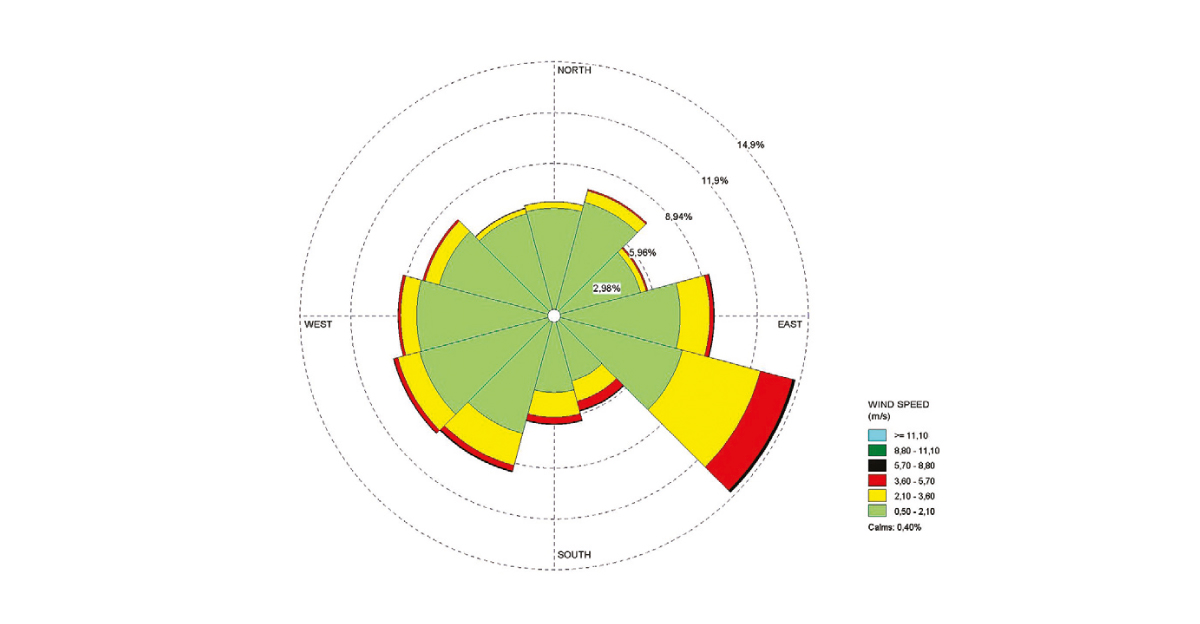
◦ El Puerto de Santa María: There is a balance between poniente and levante winds. El Puerto is affected equally by both winds, and moreover, these winds reach higher speeds than in Jerez de la Frontera (the levante wind can reach speeds of up to 8.8 meter/ s).
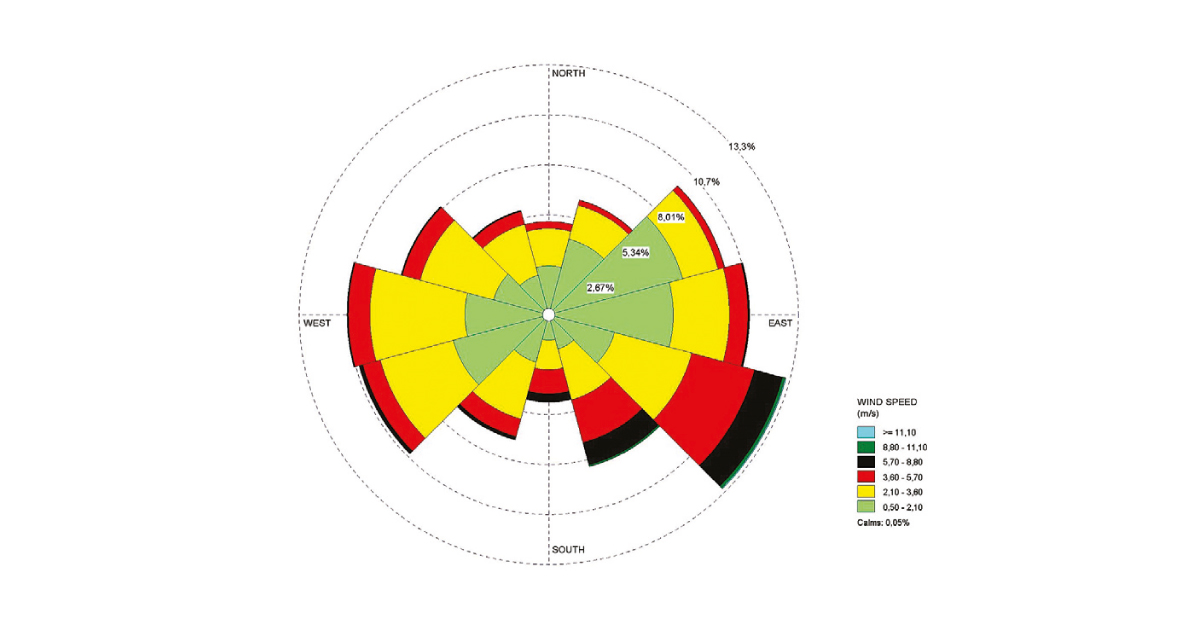
◦ Sanlúcar de Barrameda: Poniente is the predominant wind in this town, with an higher average speeds than in Jerez de la Frontera.

VARIABILITY ACROSS THE JEREZ REGION?
The presence of winds in each town or area of the region generates, as has been observed, climatic diversity throughout the region. Wind, in this case, is a key element to understand the differences between the towns of Jerez, El Puerto, and Sanlúcar, and thus, to convey these differences to the identities of each of their wines. One element directly influenced by the presence of different winds is the “flor” veil, for example.
Jerez is a warm, inland region. El Puerto and Sanlúcar are more moderate and oceanic than the first of the three towns. While broad differences can be appreciated between towns, the world contained in each vineyard, neighborhood, winery, or barrel is practically boundless, creating multiple styles, flavors, aromas, colors, and identities. A complex and multifaceted universe ready to be discovered.
Bibliography:
GÓMEZ BENITEZ, J. (2022). “Estudio del clima del Marco de Jerez (I) Características generales. Revista Enólogos, 140, pp 60-68
GÓMEZ BENITEZ, J. (2023). “Estudio del clima del Marco de Jerez (II) Características generales.







